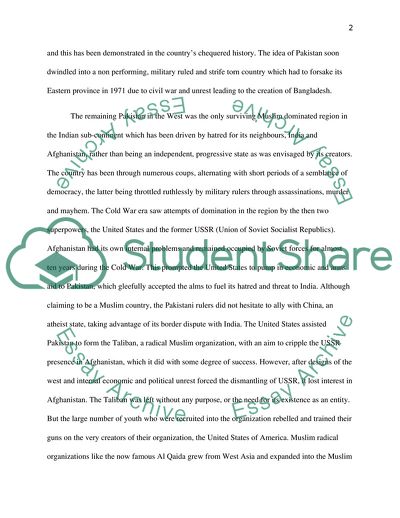Cite this document
(Explain the Nature and Extent of Pakistan's International Conflict Essay Example | Topics and Well Written Essays - 1750 words, n.d.)
Explain the Nature and Extent of Pakistan's International Conflict Essay Example | Topics and Well Written Essays - 1750 words. https://studentshare.org/politics/1774593-explain-the-nature-and-extent-of-pakistans-international-conflict-between-secularism-and-islamic-militancy-with-specific-reference-to-how-this-may-or-may-not-influence-the-insurgency-in-afghanistan
Explain the Nature and Extent of Pakistan's International Conflict Essay Example | Topics and Well Written Essays - 1750 words. https://studentshare.org/politics/1774593-explain-the-nature-and-extent-of-pakistans-international-conflict-between-secularism-and-islamic-militancy-with-specific-reference-to-how-this-may-or-may-not-influence-the-insurgency-in-afghanistan
(Explain the Nature and Extent of Pakistan'S International Conflict Essay Example | Topics and Well Written Essays - 1750 Words)
Explain the Nature and Extent of Pakistan'S International Conflict Essay Example | Topics and Well Written Essays - 1750 Words. https://studentshare.org/politics/1774593-explain-the-nature-and-extent-of-pakistans-international-conflict-between-secularism-and-islamic-militancy-with-specific-reference-to-how-this-may-or-may-not-influence-the-insurgency-in-afghanistan.
Explain the Nature and Extent of Pakistan'S International Conflict Essay Example | Topics and Well Written Essays - 1750 Words. https://studentshare.org/politics/1774593-explain-the-nature-and-extent-of-pakistans-international-conflict-between-secularism-and-islamic-militancy-with-specific-reference-to-how-this-may-or-may-not-influence-the-insurgency-in-afghanistan.
“Explain the Nature and Extent of Pakistan'S International Conflict Essay Example | Topics and Well Written Essays - 1750 Words”. https://studentshare.org/politics/1774593-explain-the-nature-and-extent-of-pakistans-international-conflict-between-secularism-and-islamic-militancy-with-specific-reference-to-how-this-may-or-may-not-influence-the-insurgency-in-afghanistan.


